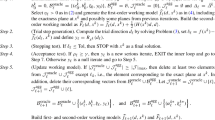Abstract
Singular integrals occur commonly in applications of the boundary element method (BEM). A simple mapping method is presented here for the numerical evaluation of two-dimensional integrals in which the integrands, at worst, are O(1/r) (r being the distance from a source to a field point). This mapping transforms such integrals over general curved triangles into regular 2-D integrals. Over flat and curved quadratic triangles, regular line integrals are obtained, and these can be easily evaluated by standard Gaussian quadrature. Numerical tests on some typical singular integrals, encountered in BEM applications, demonstrate the accuracy and efficacy of the method.
Similar content being viewed by others
References
Aliabadi, M. H.; Hall, W. S.; Phemister, T. G. (1985): Taylor expansions for singular kernels in the boundary element method. Int. J. Numer. Method Engng. 21, 2221–2236
Aliabadi, M. H.; Hall, W. S. (1987a): Weighted Gaussian methods for three-dimensional boundary element kernel integration. Comm. Appl. Numer. Methods 3, 89–96
Aliabadi, M. H.; Hall, W. S. (1987b): Analytical removal of singularities and one-dimensional integration of three-dimensional boundary element method kernels. Engng. Analysis 4, 21–24
Brebbia, C. A.; Telles, J. C. F.; Wrobel, L. C. (1984): Boundary element techniques: Theory and Applications in Engineering, Berlin, Heidelberg, New York: Springer
Cristescu, M.; Loubignac, G. (1978): Gaussian quadrature formulas for functions with singularities in 1/R over triangle and quadrangles. In: Brebbia, C. A. (ed): Recent advances in boundary element methods, London, Pentech Press, pp. 375–390
Cruse, T. A. (1969): Numerical solutions in three-dimensional elastostatics. Int. J. Solids Structures 5, 1259–1274
Guiggiani, M.; Gigante, A. (1990): A general algorithm for multidimensional Cauchy principal value integrals in the boundary element method. ASME J. Appl. Mech. 57, 906–915
Huang, Q.; Du, Q. (1988): An improved formulation for domain stress evaluation by boundary element methods in elastoplastic problems. Proceedings of the China-U.S. Seminar on Boundary Integral Equation and Boundary Finite Element Methods in Physics and Engineering, Xian, China
Lachat, J. C.; Watson, J. O. (1976): Effective numerical treatment of boundary integral equations: A formulation for three-dimensional elastostatics. Int. J. Numer. Method. Engng. 10, 991–1005
Lean, M. H.; Wexler, A. (1985): Accurate numerical integration of singular boundary element kernels over boundaries with curvature. Int. J. Numer. Method. Engng. 21, 211–228
Li, H.-B.; Han, G.-M; Mang, H. A. (1985): A new method for evaluating singular integrals in stress analysis of solids by the direct boundary element method. Int. J. Numer. Method. Engng. 21, 2071–2098
Mukherjee, S. (1992) Boundary element methods in creep and fracture. London: Elsevier
Nishimura, N.; Kobayashi, S. (1989): A boundary integral equations method for consolidation problems. Int. J. Solids Structures 25, 1–21
Pina, H. L. G.; Fernandes, J. L. M.; Brebbia, C. A. (1981): Some numerical integration formulae over triangles and squares with a 1/R singularity. Appl. Math. Modelling 5, 209–211
Rajiyah, H.; Mukherjee, S. (1987): Boundary element analysis of inelastic axisymmetric problems with large strains and rotations. Int. J. Solids Structures 23, 1679–1698
Rand, R. H. (1984): Computer Algebra in Applied Mathematics: an Introduction to Macsyma. Pitman, Boston
Sarihan, V.; Mukherjee, S. (1982): Axisymmetric viscoplastic deformation by the boundary element method. Int. J. Solids and Structures 18, 1113–1128
Zhang, Q.; Mukherjee, S.; Chandra, A. (1992a): Design Sensitivity Coefficients for elastovisco plastic problems by boundary element method. Int. J. Num. Meth. Engng. 34, 947–966
Zhang, Q.; Mukherjee, S.; Chandra, A. (1992b): Shape design sensitivity analysis for geometrically and materially nonlinear problems by the boundary element method. Int. J. Solids Structures 29, 2503–2525
Author information
Authors and Affiliations
Additional information
Communicated by S. N. Atluri, September 12, 1992
Rights and permissions
About this article
Cite this article
Nagarajan, A., Mukherjee, S. A mapping method for numerical evaluation of two-dimensional integrals with 1/r singularity. Computational Mechanics 12, 19–26 (1993). https://doi.org/10.1007/BF00370482
Issue Date:
DOI: https://doi.org/10.1007/BF00370482




